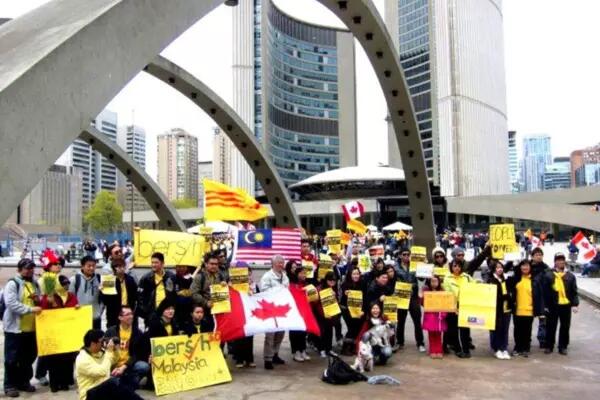Jacques Bertrand is a professor of Political Science and the director of the Collaborative Master’s Specialization in Contemporary East and Southeast Asian Studies at the Munk School’s Asian Institute. His new book, Democracy and Nationalism in Southeast Asia, explores the complex factors influencing the outcomes of nationalist conflict in emerging democracies.
Your book examines the impact of a number of variables affecting peace and conflict in Southeast Asia. Your preface mentions that you’d been planning it for a long while. Was there an event or a moment that inspired you to take on a detailed comparison like this?
I think it would be fair to say that my interest in this comparison grew out of a gradual and cumulative set of events and circumstances, rather than any specific one. It probably started as far back as the downfall of President Suharto in Indonesia in 1998. Against what specialists of Indonesia might have expected, the opening up of the country to democracy saw a rise in violent ethnic conflict in many forms, but including an escalation of violent insurgency in Aceh, large-scale mobilization for referenda on independence both in Aceh and Papua, and the similar violence leading to the independence of East Timor (now Timor Leste).
Fast-track to 2005, there was the tsunami that destroyed large parts of Aceh, and some thought largely contributed to the peace agreement with the Free Aceh Movement (GAM) in 2006. I took issue with this perspective as resolving conflict is usually much more complex. Also, I continued to be disturbed at how unsuccessful Papuans were at obtaining recognition of past wrongs and gaining levels of autonomy in which they would be invested. Since I had also previously been to the south of the Philippines, and worked a bit on the Moro struggle there, the parallels became quite clear.

You spend time in the introduction and second chapter defining nationalist groups. Why do you think that “nationalist” increasingly means different things to different people?
Yes, I think there is a need to clarify and specify what we mean when we use different labels and categories of analysis. Some labels become over-used, and lose, over time, their analytical strength. Others become loaded with certain connotations and controversy. This is particularly true with the analysis of identity. We have long used the loaded terms “ethnic” or “ethnic conflict”. “Nationalist” is also one of those analytical categories. Some impute certain kinds of behaviours or attitudes to “nationalist” groups and relate them historically to the racist and expansionist agenda of Nazi Germany, or to the rise of right-wing extremists in the contemporary setting. In academia, we sometimes see “nationalist” equated with “ethnic” groups, essentially making a direct association with the political mobilization of any identity based on kinship ties or region.
It was important for this book to clearly define nationalist in line with now decades of study of nationalism that clearly distinguishes “nationalist” as primarily a political identity that self-ascribes a group as a nation with the explicit purpose of seeking self-determination. This does not necessarily coincide with notions of “ethnic identity”, as defined in terms of characteristics such as common language, or sense of kinship. And, as the book emphasizes, it is that political objective of self-determination that becomes the primary threat to the state, and that distinguishes these types of conflict from others and why they have different outcomes under democratic governance. It’s not about the identities (based on language, religious or other characteristics) that sometimes also differentiate these groups from majorities in control of the state.
On the side of nationalist groups, are there any groups that have done a particularly good job of engaging and advocating with the state?
When looking at groups that I studied in Southeast Asia, there were a couple that were most successful at gaining the state’s attention. Unfortunately, some of these were long time, well organized, violent insurgent groups but I don’t think that it was the primary reason they were successful at obtaining peace agreements. The Acehnese, for instance, obtained a peace agreement in 2006 and the Moro Islamic Liberation Front were successful in 2018. Certainly their persistence was helpful but their learning was essential too. It helped that they learned over time to accept negotiations that would lead to detailed commitments, well enshrined in elaborate agreements and legislation that was specific. It sounds almost technical, but many groups naively engage the state and reach agreements, only to realize that they were given less than they had hoped for, and a new cycle of violence begins. This is what happened with the Moro National Liberation Front in an earlier peace agreement.
Another interesting example in the book was the Cordillerans, who were never really able to mobilize successfully around a nationalist strategy but became highly successful when they pivoted their strategy to tap into the world Indigenous movement, and leveraged international allies and emerging norms for Indigenous rights to engage the state in recognition self-determination and rights for Indigenous peoples. At least on paper, the gains made were very impressive.
How important is it for nationalist groups to have the support of the wider population?
This question raises a really thorny issue in reaching agreements with nationalist groups. The cases in this book are all nationalist groups that are territorially concentrated, can claim a historical homeland, but are a small percentage of the total population of these countries. There are a large number of such groups in countries across the world. But the population as a whole, in most countries, tends to be unsympathetic to nationalist claims, oftentimes ignorant of the historical grievances, and generally supportive of arguments for refusing to negotiate. As the book explains, the relative independence of parliament and electoral incentives are key to achieving the political support for a credible and sustainable peace agreement, and subsequent constitutional changes or legislation. It requires that, at the very least, this coalition of support can be sold to a sufficiently large segment of the population to ensure that these two mechanisms don’t contribute to failure. So overall some relatively broad buy-in is necessary, and is often achieved unfortunately when there is general fatigue from years of violent mobilization, which becomes increasingly unacceptable in a democratic context.
What lesson(s) do you hope your audience(s) take away?
The first lesson is that democracy is neither a curse nor a solution in itself for resolving nationalist conflicts. The book supports the view that, in most cases, democracy does tend to reduce violence and therefore the fears that some scholars had, based on transitions mostly from post-Soviet cases, didn’t pan out. Elections and uncertainty can fuel violence in the short term, but it happens only under specific circumstances. The converse, on the other hand, is too optimistic. While democracy can offer new opportunities to voice grievances, gain some representation, even new powers and resources, its record is actually poor at adequately addressing the claims of nationalist groups and finding solutions that last. We need to better understand more specific circumstances that are more conducive to such solutions.
A second lesson is that early state concessions, especially unilateral ones, can go a long way at preventing a resurgence of violent conflict, but there are also some pernicious outcomes. If they are genuine attempts to bridge a gap with nationalist groups, they can lead to productive negotiations. But oftentimes these early concessions are strategic attempts to defuse violence in the short term, divide nationalist groups, coopt leaders and refrain from addressing the more significant issues behind nationalist group mobilization. This can be a crucial stage of misunderstanding that sets off cycles of violence.
The third is that top-down, state-imposed solutions rarely work. Even if autonomy or a substantial amount of fiscal resources can be devolved to regions, with nationalist groups benefitting, it is very difficult to entice groups to accept and truly espouse new autonomous powers, or acquired fiscal resources, without involving them in a negotiated settlement. There is no good substitute to genuine negotiation.
The fourth, mostly for nationalist groups, is to approach negotiations with a high degree of preparedness. In a number of cases in the book, it became clear that the state often times tries to tack back through surreptitious means what it gives out in highly publicized, high profile agreements. The devil is oftentimes in the detail, as implementation and the less glamorous realm of detailed legislation, fiscal formulas and regulation can sometimes greatly undermine autonomy agreements that have been reached. The most successful agreements, such as in Aceh, were very elaborate and sufficiently detailed to greatly increase its credibility and chance of extending genuine and significant autonomy that addressed grievances.
Was there a part of this book that inspired your next?
Yes, part of the book did inspire my two projects. While I was working on this issue of democracy and nationalist groups in Southeast Asia, dramatic changes began to occur in Myanmar, which began to open up and democratize to some extent. I became very interested in analyzing the impact of this new partially democratic framework on the sixty-year civil war with several nationalist groups. While there are interesting parallels with this book, I chose to only mention them marginally here, in part because the political context has been different, due to the partial nature of democracy. But it led to a parallel project where I have been working on state and nationalist groups’ strategies in negotiations that span several arenas, from formal negotiations to state institutions.
My other, very recent project will be examining various aspects of war-to-peace transitions, and analyzing the problem of civil war recurrence, specifically focusing on circumstances that motive insurgent groups to return to war. Along with my collaborators, we are working on the premise that the various aspects of reintegration after peace need to be analyzed more fully, from joining political parties to reintegrating economic activities.



